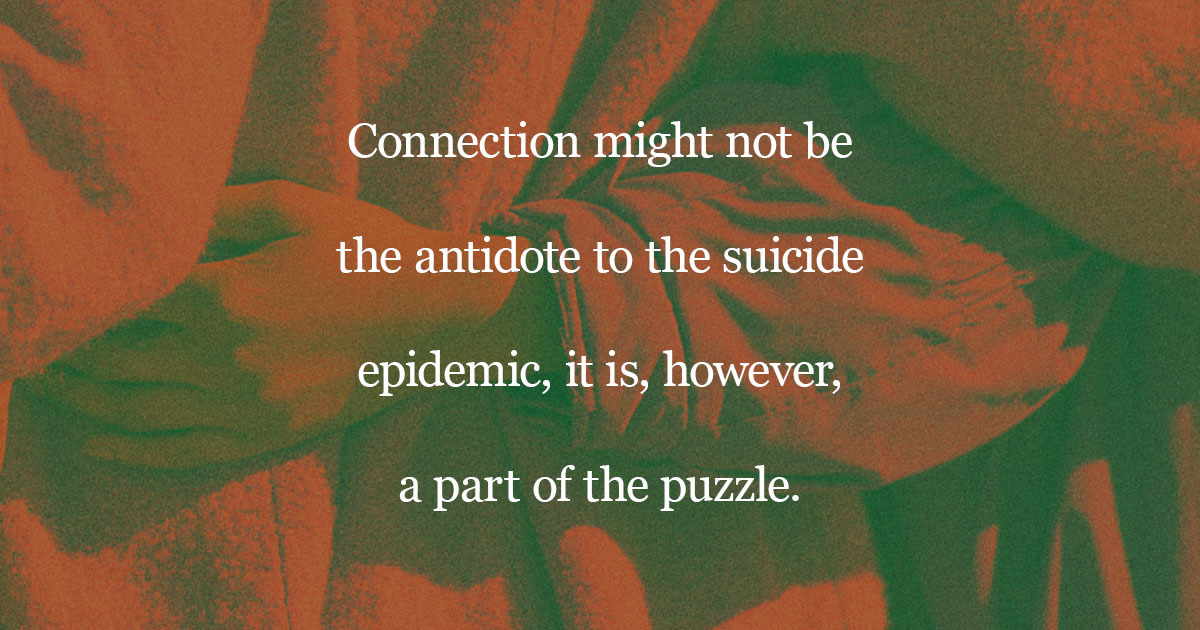I was terrified. Terrified to speak it out loud. Terrified to type it out as a text message and press send. Terrified to have another person know what I was thinking, what my brain was saying and telling me.
“You should swerve off this bridge.”
“It would be so easy to crash this car.”
If you read what I wrote last year, you know I told someone—a friend.
It could have gone way differently, I’m sure, if I hadn’t told said friend about my brain’s musings. Because in that moment of spiraling thoughts—spiraling thoughts of suicide—I could have clutched so tightly to what was happening inside my head as if it needed to be kept a secret.
The forces of shame, fear, and stigma were hard at work. They gave it their best, trying to convince me that silence was the best course of action.
Shame whispered, “You need to pretend that everything is fine. You should be fine.”
Fear declared, “If you tell someone you’re having thoughts about suicide, it’ll make it more real.”
And Stigma stated, “If you admit to having these thoughts, people will see you differently.”
But even with those things knocking around my head, I didn’t want to sit with it alone. I didn’t wish to face the darkness by myself. For I knew the isolation would (or at least could) give room for the thoughts to grow in intensity, in depth, and in numbers. Because, as many of us probably know, “keeping secrets can make us sick.” So while telling a friend might not be the only action you have to take, it’s a damn good place to start. Bringing a friend into the equation eliminates isolation, and isolation is where shame, fear, and stigma thrive. The three things that nearly convinced me to put a lid on what I was experiencing.
Suicide prevention isn’t just one thing. Connection might not be the antidote to the suicide epidemic, it is, however, a part of the puzzle. Your puzzle might look different than mine. It may include a hospital stay, dialing 988 to talk to someone, or creating a safety plan. But I can almost guarantee there will be a piece to everyone’s puzzle that involves being vulnerable and seeking comfort from other people. Safe, kind, and understanding people. People who do their best to set aside judgment, welcome nuanced conversations, and place compassion ahead of everything else. They don’t have to be “perfect” people or professionally trained in mental health, but rather, they are safe and willing to listen.

And yes, I did say “everyone’s puzzle.” Because suicide, while more prevalent depending on an array of factors, can happen to literally anyone. Thoughts, attempts, and loss. Suicide impacts more people than we can begin to imagine, than we can even possibly know. Through silence and hesitation, we are made to feel that if we experience anything related to suicide, we are weak and broken and wrong. But the reality is that suicide isn’t uncommon. While I wish it was, I also find it encouraging to know that this isn’t something a select few have been subjected to. We are not alone.
That’s why prevention applies to all and should start well before a moment of crisis. Putting preventative measures into place can seem extreme—but I don’t think it is. There are also super small steps you can take.
- Invite someone into the conversation (or you can even just have a specific person in mind if the moment does arise)
- Create a safety plan (here, have a template!)
- Share the heavy (Are you anxious, depressed, burnt out? Tell someone.)
Whatever you are facing, there is always hope. And we will hold on to hope until you’re able to grasp it yourself. If you’re thinking about suicide, we encourage you to use TWLOHA’s FIND HELP Tool to locate professional help and to read more stories like this one here. If you reside outside of the US, please browse our growing International Resources database. You can also text TWLOHA to 741741 to be connected for free, 24/7 to a trained Crisis Text Line counselor.